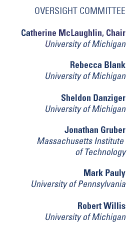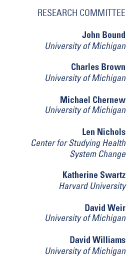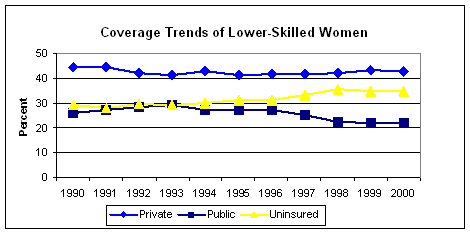|



The University of Michigan
555 South Forest Street
Third Floor
Ann Arbor, MI 48104-2531
T 734-936-9842
F 734-998-6341
/
|
 |
 |
Decline in Private Coverage Drives Uninsured Rate for Less-skilled Women
THE PROBLEM
Women lacking a high school diploma are among the most likely group of Americans to be without health insurance. According to a new study, these women (whom the authors define as less skilled) are twice as likely to be uninsured as women who complete high school, and more than three times more likely to lack coverage than female college graduates. The uninsured rate has climbed substantially for these women in the last two decades, even during the economic boom times of the 1990s, with more than one-third (36 percent) of less-skilled women among the ranks of the uninsured in 2006.
The increase in uninsured rates among women without a high school diploma in the late 1990s has been blamed on changes in welfare policy due to the Personal Responsibility and Work Opportunity Reconciliation Act of 1996 (PRWORA). But new research funded by the Economic Research Initiative on the Uninsured (ERIU) at the University of Michigan shows that although welfare recipients were more likely to lack coverage following PRWORA, welfare reform actually had a small positive effect on coverage trends for less-skilled women who had not received welfare benefits prior to reform. The work by Michigan State University economist Thomas DeLeire and colleagues from the University of Chicago and the University of Michigan, used data from the Current Population Survey (CPS) to examine health insurance trends of all women without a high school diploma, not just the 10 percent who were on public assistance in the years before welfare reform took effect.
Gains in private health insurance coverage associated with welfare reform for this subset of less-skilled women were not enough, however, to offset the cumulative effect of other factors that caused a much larger decline in employment-based coverage for this group throughout the 1990s. As a result, coverage rates for women without a high school diploma declined by 10 percentage points between 1988 and 2000.
|
|
This research highlights the importance of looking beyond simple trends over time, or even the average aggregate effects of a policy change. The results are largely consistent with other ERIU-funded studies--by Bobbie Wolfe, George Borjas, and Mike Christian--showing an increase in employment-based coverage that can be directly associated with welfare reform. But as this study shows, because the positive effect of welfare reform was so small and for only a subset of these women, the larger trend during this time period was one of declining employment-based coverage, especially for those with fewer skills. While coverage levels are low and have declined among all women with less than a high school education, single mothers and women lacking much work experience face even greater challenges in securing employment-based coverage. Whether it's due to a strong economy or to a policy like welfare reform, increases in labor force participation are not likely to solve the problem for the large number of workers who still won't have access to employer sponsored health insurance, either directly or indirectly. While increasing the skills of this pool of workers will result in coverage for some, policymakers need to recognize that unless we change the basis for offering employment-based coverage, work alone won't solve the coverage problems for most lower-skilled workers.
From Catherine McLaughlin,
Ph.D., Professor at the University of Michigan and Director of
ERIU |
THE FACTS
-
Less-skilled women are particularly vulnerable to being uninsured. In 1988, 27 percent of less-skilled women were uninsured; by 2000, the rate had risen to 35percent. In 2000, 16 percent of women with high school degrees were uninsured, compared to 7.9 percent of female college graduates. Uninsured rates for all women rose in the 12-year timeframe, peaking in 1998 before moderating slightly by 2000.
-
Health insurance got tougher to obtain for less-skilled women. Among those less-skilled women with coverage, about two-thirds get it from private sources (via their or their spouse's employers or bought in the individual market), while one-third are covered by Medicaid or other public programs. While Medicaid coverage for less-skilled women dropped slightly (23.4 percent in 1998 to 22 percent in 2000), the percentage with private health coverage dropped from nearly 50 percent to 43 percent during that time. The decline in private coverage would have been even steeper if not for the small (roughly 3 percentage point) increase in the likelihood of having private coverage associated with welfare reform.
-
Welfare reform did put subsets of certain lower-skilled women at higher risk of being uninsured. Women on public assistance were more likely to be uninsured after welfare reform took effect. Meanwhile, lower-skilled black women overall did not share in the benefits that welfare reform brought to other groups of lower-skilled women.

Q&A with Thomas DeLeire, Ph.D
Thomas DeLeire is a professor in Michigan State University's Department of Economics. DeLeire, a labor and health economist, has examined various aspects of welfare reform. DeLeire, on leave from MSU during the 2006-2007 academic year and working as a senior analyst at the Congressional Budget Office, talked to ERIU about the paper he co-authored for ERIU, entitled "Is Welfare Reform Responsible for Low-skilled Women's Declining Health Insurance Coverage in the 1990s?"
Q: What spurred you to do this research?
A: The 1990s saw dramatic increases in Medicaid eligibility, particularly for children, and large increases in employment and in earnings among this group of women. This was a period that saw welfare reform and other policy changes, and we wanted to see how lower-skilled women were faring in terms of their health insurance coverage.
Q: What percentage of American women does not have a high school degree? And what percentage was on welfare just before the Personal Responsibility and Work Opportunity Reconciliation Act of 1996 kicked in?
A: About 15 percent of all women do not graduate high school. In the years prior to welfare reform, roughly 10 percent of women with less than a high school degree would be on Aid to Families with Dependent Children (AFDC) in any given year.
Q: What makes lower-skilled women more vulnerable to being uninsured?
A: First of all, they are going to be less likely to be working. Only half of the women with less than a high school education had a job during this whole time period. Of those who did work, a greater fraction of them worked part-time or part-year. Having a part-time or part-year job is related to being not offered health insurance. They are also less likely to be married so they cannot be covered through a spouse.
Q: Don't most people think that welfare reform was a big reason why some women lost health coverage?
A: Yes, the conventional wisdom is that welfare reform probably contributed to the decline in health insurance coverage. Partially, this has been backed up by research that has followed women who left the welfare rolls during this period. Typically these studies found declines in health insurance coverage among these women. Where our study differs is that we are examining not just former welfare recipients, but trends in health insurance coverage for lower-skilled women more generally, that includes a lot of women who were not former welfare recipients.
Q: What does your research show?
A: When we went to look at this broader population, it seems welfare reform provided an incentive for lower-skilled women to either seek increased private coverage, perhaps by taking more highly rewarded or more stable employment. Maybe they were more likely to get married as a result of welfare reform and receive coverage through their spouse. Looking at a broader set of women who could potentially be affected in a positive way by changes in the welfare system, you tend to pick up some of these positive effects. If you only look at former welfare recipients, who are coming from a situation where virtually all of them were covered by public health insurance, they have no where to go but down.
Q: So is your theory that without welfare reform, the uninsurance rates for lower-skilled women would have been higher?
A: That's right. Our bottom-line finding is that the women with less than a high school degree experienced an 8 percentage point decline in health insurance coverage during the 90s. This was partially offset by welfare reform. In states that implemented waivers, lower-skilled women in those states had coverage rates that were 2.3 percent higher than women in states without waivers. After Temporary Assistance to Needy Families (TANF) was implemented, we estimated that it increased the insurance coverage rates of lower-skilled women by 3.6 percentage points compared with states with no reforms. Those increases are fairly modest compared to very large declines these women experienced overall.
Q: What is the message here to policymakers?
A: The lesson to policymakers is that policies that affect labor supply potentially affect the insurance coverage rates of lower-skilled groups. There is some potential for individuals to seek better jobs, to seek coverage, to seek jobs with health insurance coverage. But there is only so much that increased labor supply can do. The effect of welfare reform may have been positive in terms of health insurance coverage, but in no way were the gains large enough to offset the secular trends in declining health insurance coverage for these women. In no way should we be any less concerned about the uninsured rates among lower-skilled groups. It is still becoming a greater problem.
|
UPCOMING
|
This Research Highlight is the 13th in a series of research-based policy documents that address current questions and issues related to the health care coverage debate. The next Research Highlight will examine trends in uninsured rates for Asian and Latino subpopulations.
For text of the full interview and paper, or a summary of the findings, data, and methods, visit ERIU's website at . |
Other ERIU Research Highlights

Back to top

Funded by The Robert Wood Johnson Foundation, ERIU is
a five-year program shedding new light on the causes and consequences
of lack of coverage, and the crucial role that health insurance plays
in
shaping the U.S. labor market. The Foundation does not endorse the findings
of this or other independent research projects.
|
